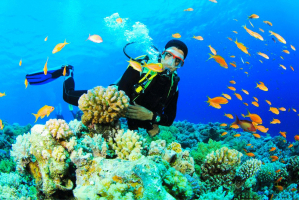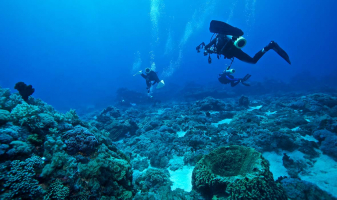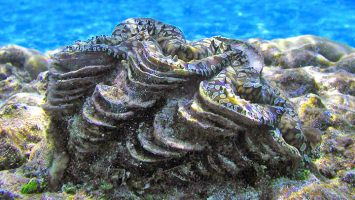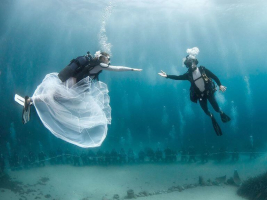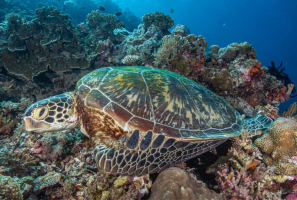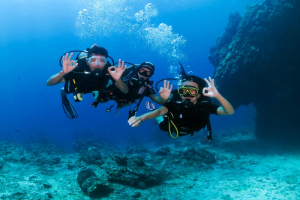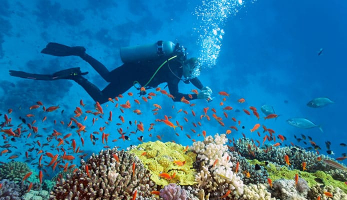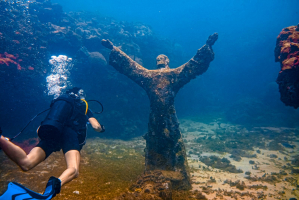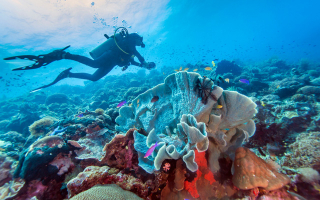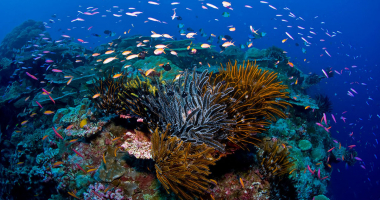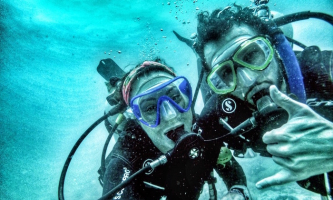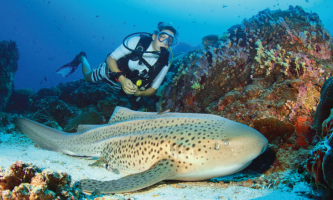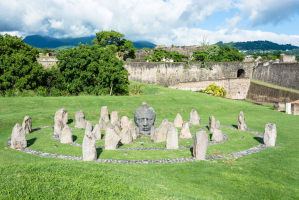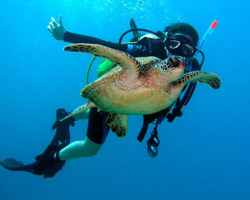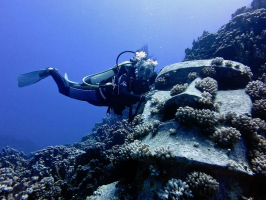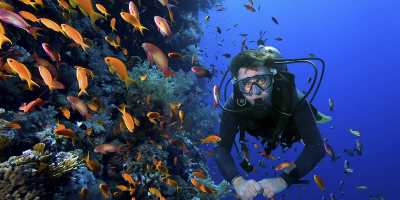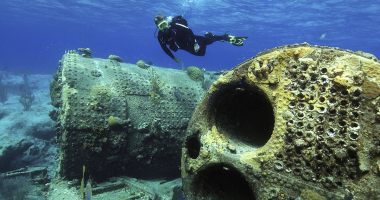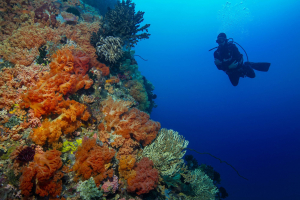Top 15 Best Dive Sites in Guadeloupe (France)
Scuba diving is one of the primary reasons people visit Guadeloupe's secluded and untamed islands. Diver levels and variety vary substantially throughout the ... read more...archipelago's dive locations. There will be diving spots suited for open water as well as more advanced levels. This article shows you about best dive sites in Guadeloupe (France).
-
The most famous diving site in Guadeloupe is the Grotte aux Barracudas, a beautiful blue cave. It is now home to a big school of barracudas that circle about in the water. Because of the depth, this dive site is for advanced divers only, and it is suitable for any experienced divers who want to view the underwater wonder.
Located further north than the Eye (north of Exuma), this dive is for experienced divers, not because of its difficulty but because of its depth of 20-22 m. The boat anchors on a bottom of 7 m. On the plate already an opening is emerging: a small very low arch allowing the passage of a diver. It is lined with royal and Brazilian lobster. An inexperienced diver can spend a good half hour here, the depth not exceeding 10 m. Rich in much coral fish, this small perimeter cannot leave anyone indifferent.
- One of Jacques Cousteau's favorite diving sites.
- There are a lot of Barracudas.
- It's a great place to watch invertebrates.
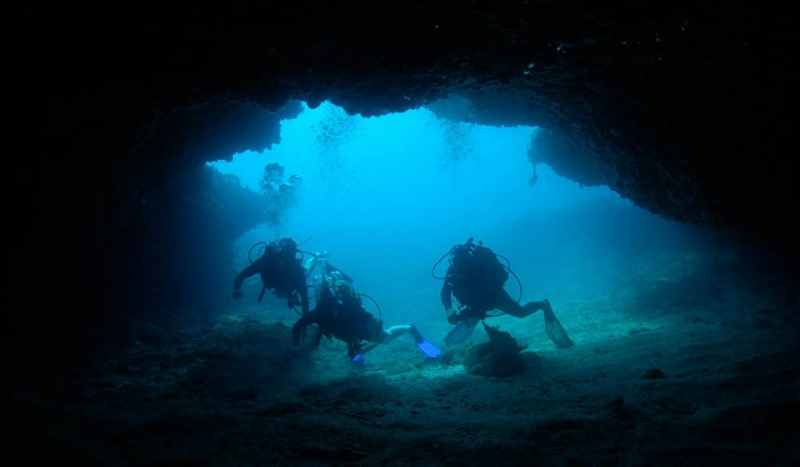
divein.com -
The 173-foot L'Augustin Fresnel was formerly a lighthouse ship assigned to the Pointe a Pintre center in the early 1990s. It was installed there to keep the region safe while the buoys in Antilla and Guyana were being maintained. During a hurricane season, it was transferred to Guadeloupe and sunk in 2003 at a depth of 82 feet. Storm DEAN, an exceptionally powerful hurricane, drove the whole wreck further down 108 feet. It is currently a stunning artificial reef and a popular destination for advanced and wreck divers. Lying on a 30 m depth, this 53 m long wreck is just a few minutes' sails from Bouillante. "The Augustin" is in good condition and very colonized, you can enjoy the exterior as well as the interior of this former boat from the fleet of lighthouses and beacons.
- A deep-diving destination for experienced divers.
- A sanctuary for two huge groupers.
- Sunk with the intent of attracting scuba divers and scientific divers
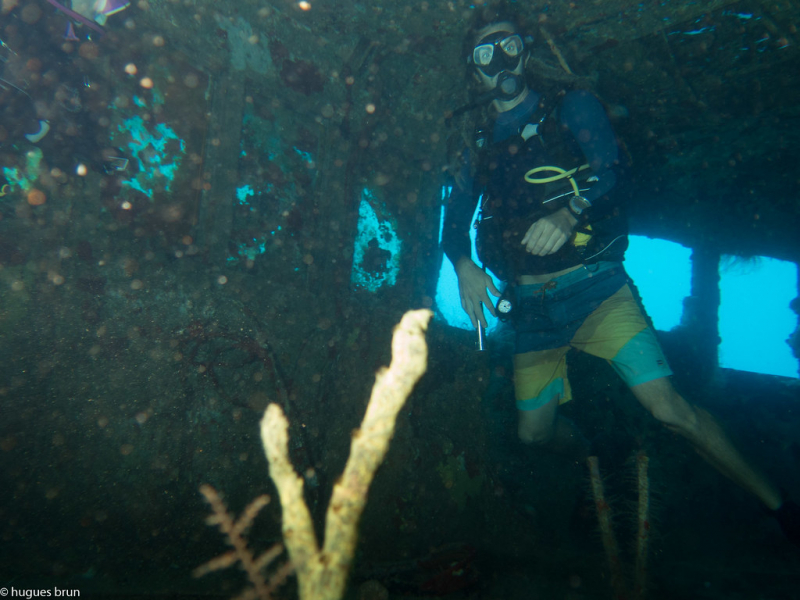
flickr.com -
This dive location is visible from the surface as a little strip of dry ground rising from the water. The drop-down from the surface is characterized by many sponges and a steady decline until 130 feet when the drop-off is abrupt. Bouillante is well renowned for its volcanic and geothermal activity, making this a fascinating diving destination with hot springs gushing from the seafloor. The National Park's final dive site to the south of Bouillante comprises a rocky ridge that will allow you to traverse between small rocky peaks and also locate 40 m. For beauty and visibility, most diving is done between 15 and 25 meters. Several hot springs in a 23-meter-deep pool, as well as a spectacular fault with several royal lobsters.
- Hot springs burst up from the seafloor as a result of geothermal activity.
- Deep dive for experienced divers
- Here you will find a unique landscape as well as aquatic life.
What you'll see: Because of the peculiarity of this dive location, you'll come face to face with an unusual assortment of sea life. Crustaceans and fish such as firefish volts, trevally, groupers, barracuda, octopus, and spotted char will be seen. The bubbles coming from the jagged reef are also warm, providing you with more hot water spouts in an already heated atmosphere. Turtles and dolphins are also frequently spotted.
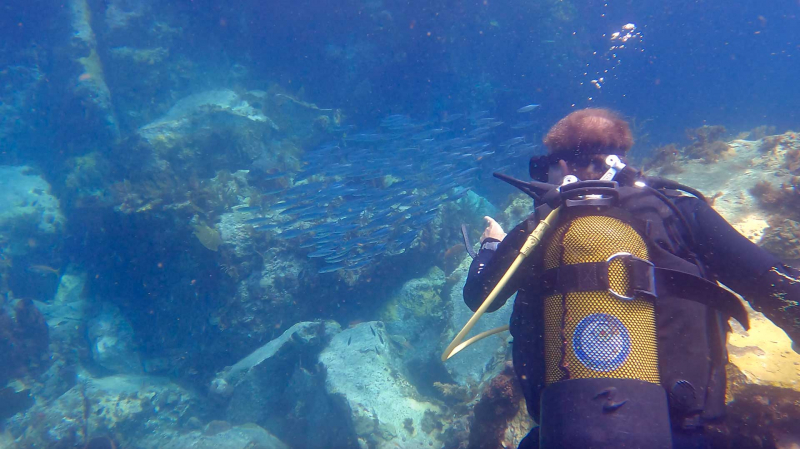
alphaplongee.com -
Sec Pate is a fantastic diving spot located between Les Saintes and Basse Terre. It's an undersea pinnacle/mountain/ancient volcano in the open sea. It begins at 15 meters and descends to 300 meters. Currents are constantly present because numerous water streams collide, mix, and must navigate their way around the peak. This implies that the conditions must be favorable in order to dive there; the current must not be too strong, and the waves must not be too high, in order to tie the boat to the mooring line, safely locate divers on the surface, and not be blown out to the ocean immediately. Sec Paté isn't for the faint of heart! Because of the frequent high currents in the vicinity, this dive site is best suited for expert open water divers. The Sec Pate diving site is centered on an underwater pinnacle resembling a row of witches' hats.
- A diversity of aquatic species is drawn to the three undersea peaks.
- This area's powerful currents are best suited for experienced divers.
- Stingrays and green moray eels should be avoided!
What you'll see: There's a lot of healthy coral growing on the underwater pinnacles, absorbing nutrients from the current. See if you can recognize the famous black coral or the many sorts of sponges. Many angelfish, small rays, damselfish, and the rare green moray eel may be seen on the reef. There are also lizardfish, stonefish, cuttlefish, goatfish, tunas, and groupers in the water!
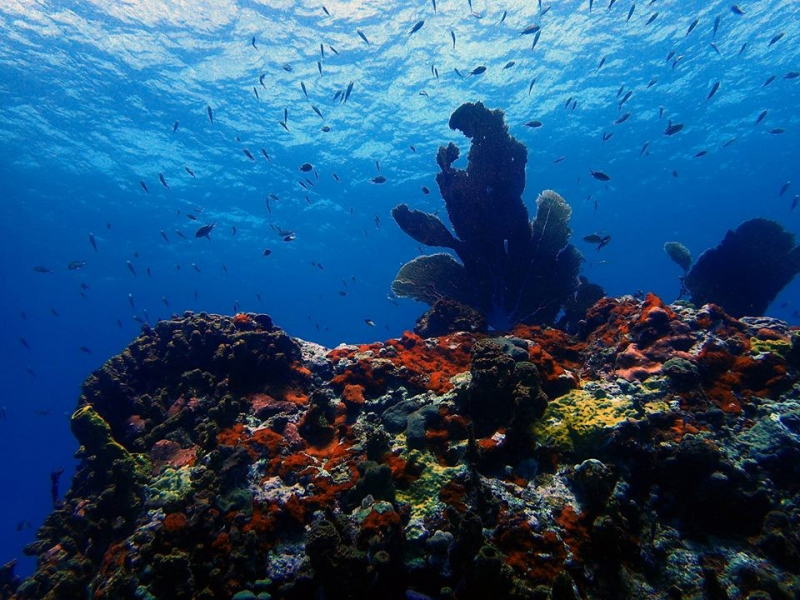
tribloo.com -
When it comes to the best dive sites in Guadeloupe (France), professional divers always mention The Quecy Point. This diving spot is not far from the well-known village of Bouillante. It's a rather shallow dive with an astounding variety of marine life. The dive spot takes divers along a reef to a tiny cave. There is also a volcanic pipe through which you may swim to get a different view of the underwater environment.
- At this dive location, divers may swim through a volcanic pipe.
- Shallow water is ideal for beginning and intermediate divers.
- Typically, there is little current but abundant marine life.
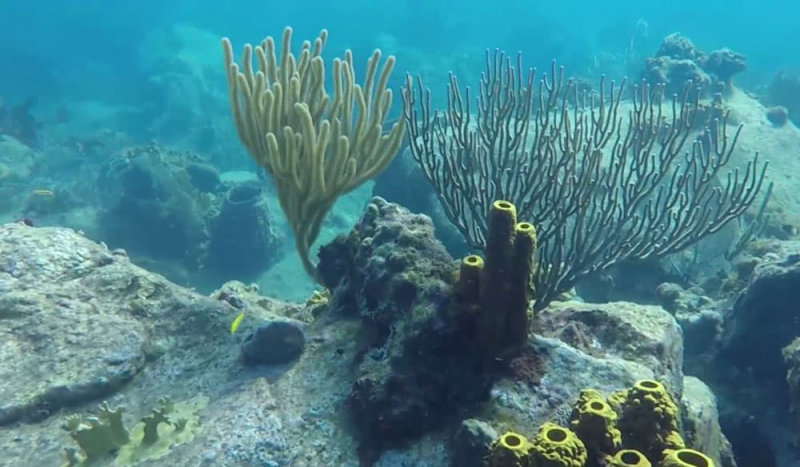
divein.com -
This magnificent coral garden is located in the Cousteau reserve and is home to some of the most stunning coral in the area. The reef can start at a depth of 6 feet and fall to a depth of 150 feet. Divers of all skill levels can explore the coral at their own depth.
The boats hang on a buoy anchored 3 to 5m deep. Going down under the boat you fall directly on a magnificent coral plateau. On the right of this coral plateau stands out a sandbank that extends from 6/7m to about 14m deep. It is in the middle of this sandbank that is the statue of the Bust of Cousteau on 12m of the bottom, sunk in 1998. This sandbar takes you straight to a drop off which descends to a depth of around 40m.
- Within the Cousteau reserve, there is an iconic dive location.
- A fantastic chance for macrofauna photographers.
- Examine a 36-foot-tall Jacques Cousteau statue.
What you'll see: There are several coral species to be seen, including both hard and soft corals. There are gorgonian fans and sponges strewn along the reef wall. Jackfish, sea turtles, and stingrays are among the aquatic fauna found in this area. Head to the 36-foot-tall Cousteau monument on the sand for a true crowd-pleaser.
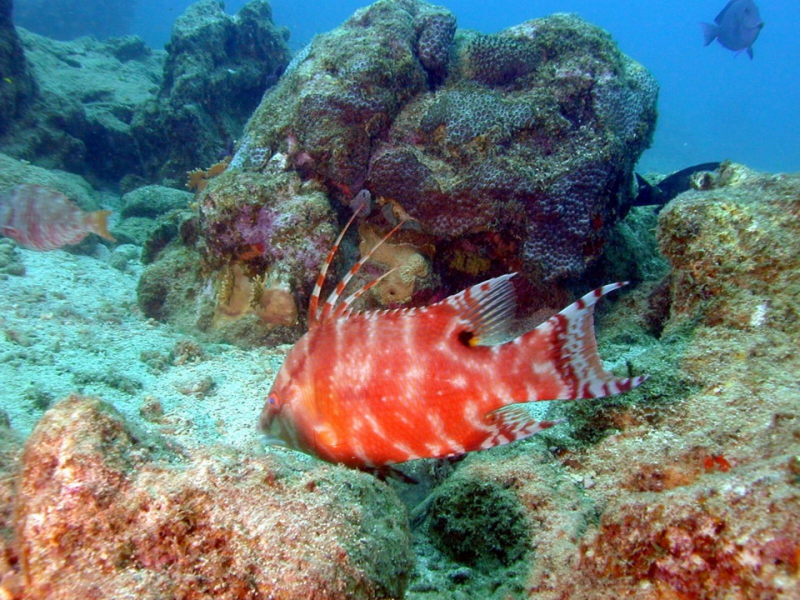
atlantisformation-guadeloupe.com 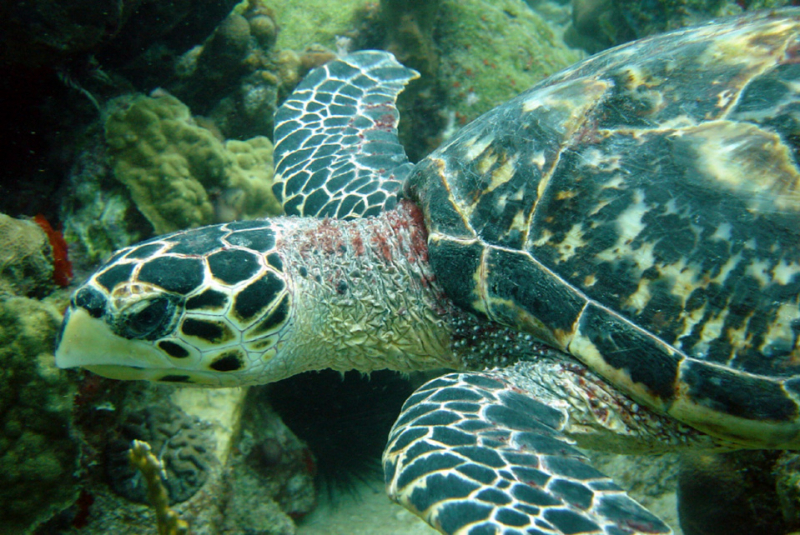
atlantisformation-guadeloupe.com -
This 49 m by 7.50 m hourglass freighter was launched in 1953 as GEOCEANIQUE and renamed GUSTAVIA in 1982. She was sunk as an artificial reef in 1991, about 1 mile from the Malendure rock at Bouillante, and now stands upright on a sand bottom at 40 meters. It's a wreck full of sponges and colorful fish. The numerous barracudas that frequent this ruin make it a very enjoyable dive. The coaster La cascade-Michaux, like many other ships in the vicinity, was pounded by a powerful storm in 1991. This ship was sunk to a depth of 127 feet when Hurricane Hugo rendered it impossible for it to return to the sea. It is currently a short boat trip away from Pigeon Island and teems with sea life.
- Deep dive for experienced divers
- On each dive, divers are surrounded by a swarm of curious fish.
- One of three deliberately sunk wrecks on Guadeloupe.
What you will see: Hundreds of interested barracudas whirl around divers on every dive around the safety stop. Sponge and soft corals cover the wreck itself. There are numerous angelfish and other schooling fish dancing around the sunken ship, creating a spectacular sight for divers. The sandy portions around the wreck's bottom are littered with eels peeking out, as well as the occasional stingray virtually undetectable in the sand.
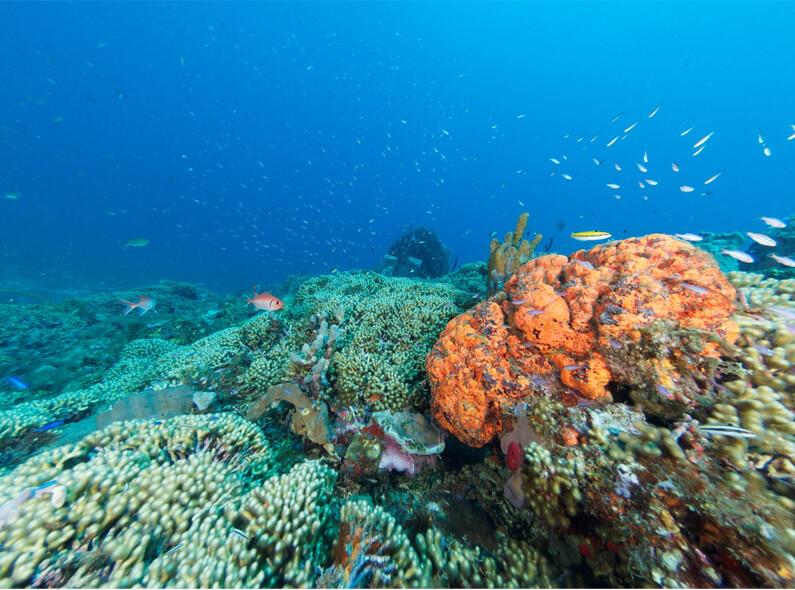
lesbaillantestortues.com 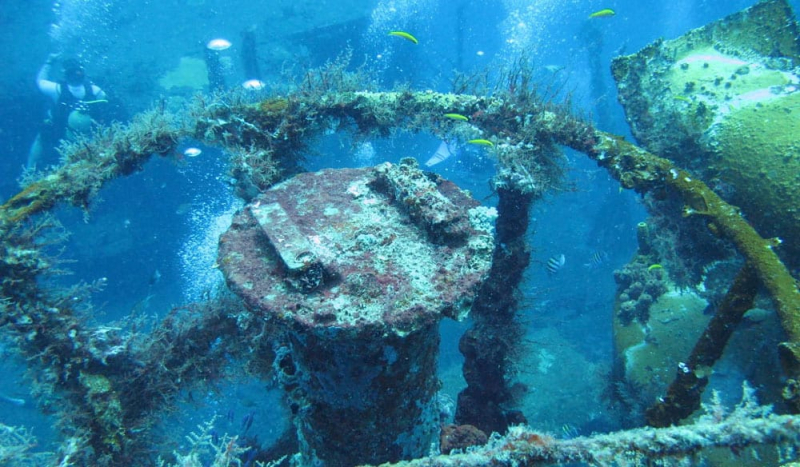
divein.com -
The Grand Cul de Sac Marin is located in the natural reserve that connects Grande-Terre and Basse-Terre. All animal and plant species are safeguarded in the natural reserve, allowing them to thrive. The reef spreads for a long distance, with many places for divers to get in and start diving.
Head to the Grand cul-de-sac Marin and sail to the wreck, one of the best dive sites in Guadeloupe (France), for a short snorkeling session. The exceptionally clear water will allow you to easily observe the many species of fish that have taken up residence in the wreck of a ship located just a few centimeters above the surface of the water. You'll then head to the reef for another snorkeling session surrounded by colorful fishes.
- It is situated in a maritime protected area.
- Near the coral reef, there are seagrass beds.
- Excellent diving site for macro photography.
What you'll see: Among the abundant coral reef is the usual suspects such as angelfish, damselfish, lionfish, frogfish, moray eels, goatfish, and others. Stingrays can also be seen swimming among the sand or well-concealed on the seafloor. Seagrass and mangrove swamps are particularly popular destinations for tiny fish because they provide protected nurseries for juveniles.
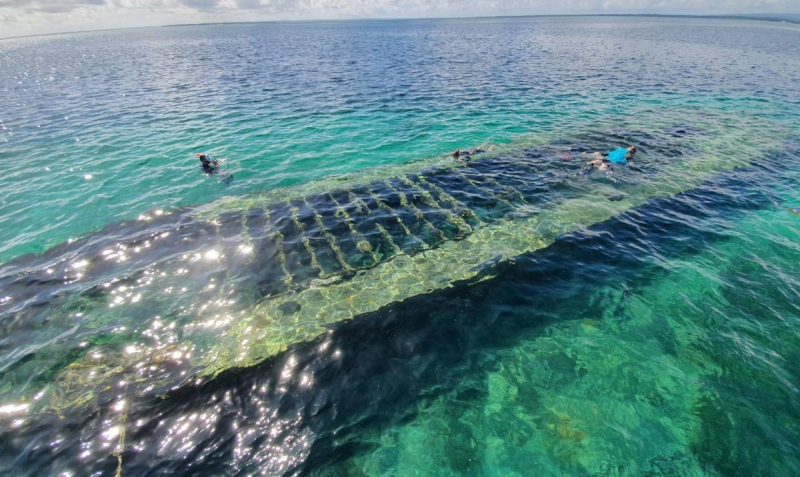
espritparcnational.com -
The Jardin Japonais (Japanese Garden) may be found off the shore of Grande Terre. It's a popular diving site for first-time divers, as well as snorkelers and swimmers. The dive location is shallow, with little current, and lush corals, making it a great destination! The Japanese garden is made up of rocks and sand bars where marine life hides and seeks in the landscape. At 32 feet in depth, there is an arch.
- Excellent location for snorkelers and novice divers.
- The shallow reef provides an excellent opportunity for amateur photographers to practice and experiment.
- A plethora of coral and aquatic creatures
What you'll see: Angelfish, damselfish, butterflyfish, wrasse, goatfish, moray eels, stingrays, crabs, brittle stars, and cleaner fish call this healthy coral reef home. There are also gorgonian fans, hard corals, soft corals, and sponges can be found! Keep your eyes peeled for tuna or barracuda in the blue!
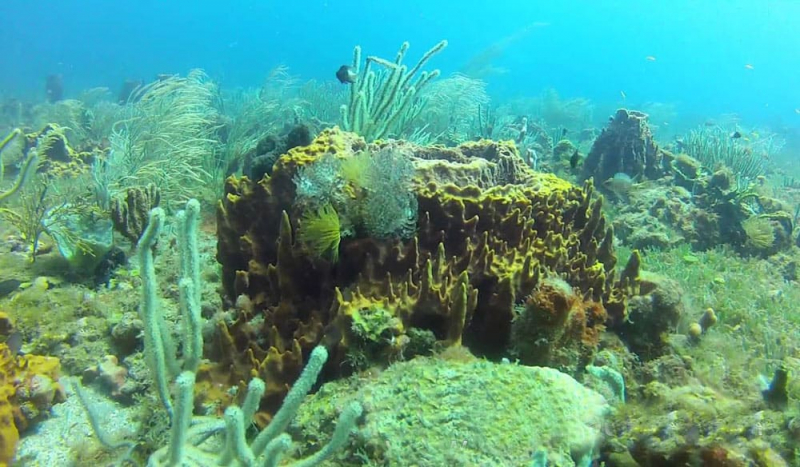
divein.com 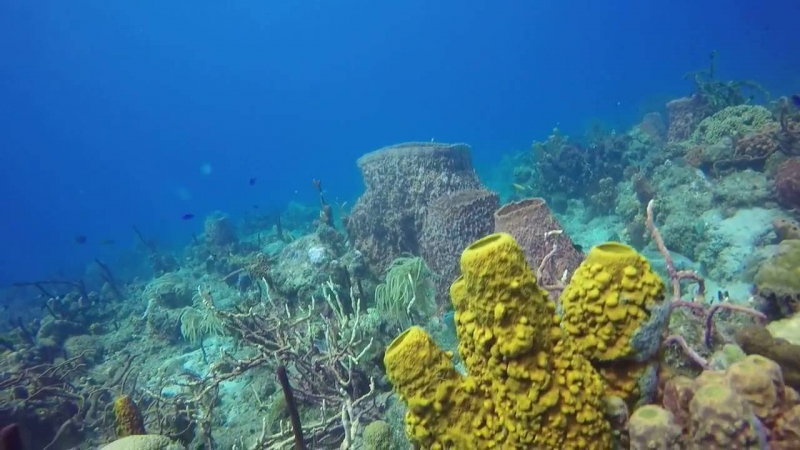
youtube.com -
The Aquarium, a great diving location for beginners, is located in the Caribbean Sea, in the Port Luis district of Guadeloupe. Divers at the Cousteau Reserve may see a variety of marine species, including turtles and gorgeous gorgonians. A glass-bottom boat may take you on a new style of exploring this place for youngsters or non-divers! This beginner-friendly dive location starts at a shallow depth and progresses to deeper depths for more experienced divers. Because of its shallow depth, this dive location is also ideal for photography practice and a lengthy drive. This diving spot is one of the best dive sites in Guadeloupe (France). It is chosen by many divers and tourists as the ideal place to dive
- Excellent diving location for photographers.
- Divers of all levels may enjoy the varied depths.
- This location is home to a large number of sea turtles.
What you'll see: This diving location is home to a variety of fish, including frogfish, damselfish, stonefish, triggerfish, and pelagic. If you like sea turtles, this is a terrific dive site for you. These species can commonly be seen gliding smoothly across the reef, napping beneath ledges, or coming up to the surface for a breath of air. If you want to have a great turtle experience, avoid making eye contact with it because this will allow you to approach it closer without threatening it.
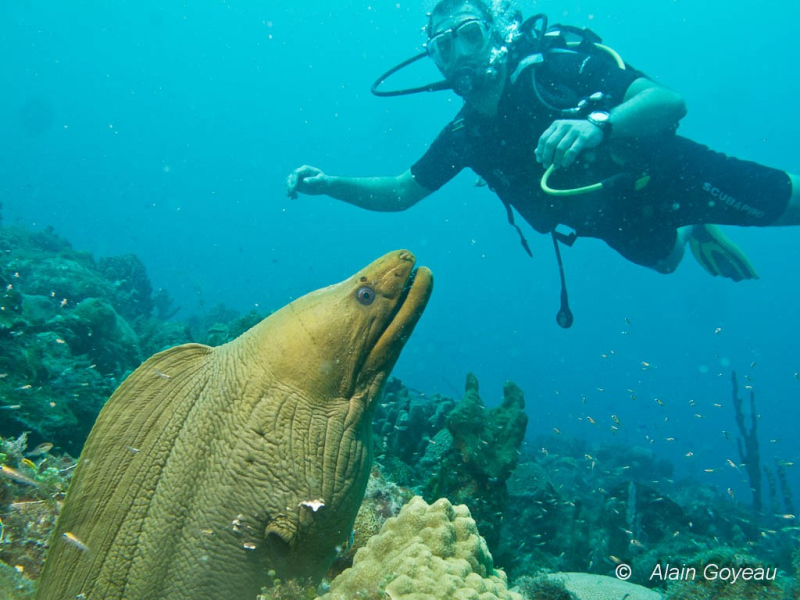
tribloo.com -
The Franjack is lying flat on her keel on a sandy bottom at 24 m in fair overall condition, with the exception of a collapsed front cabin. There are green moray eels and lobsters in the engine hold of the Franjack; there is always a surprise. The wreck is completely covered in sponges. The Franjack is a wreck that was sunk in Guadaloupe in 1996 to construct an artificial reef for divers. In addition to Le Gustavia and Láugustin Fresnel ll, It is one of three wrecks that may be found in the Archipelago. Le Franjack is a 50-meter-long ship that has come to rest on its port side as a result of hurricane Berta. Because the wreck is located in a shallow dive location, it is suitable for divers of all skill levels.
- Dive location for intermediate divers at an artificial reef
- One of Guadaloupe's three wrecks
- Ideal for photography since it is covered in coral growths and aquatic critters.
What you'll see: The wreck is located at a depth of 78 feet on a sandy spot. The wreck is lushly overgrown with hard and soft corals, as well as gorgonian fans. Schools of fish will swirl around the creepy metal skeleton as you swim around. On any given dive, triggerfish, grunts, damselfish, and crabs can be spotted. Spiny lobsters, stingrays, and crabs can also be found within coral development.
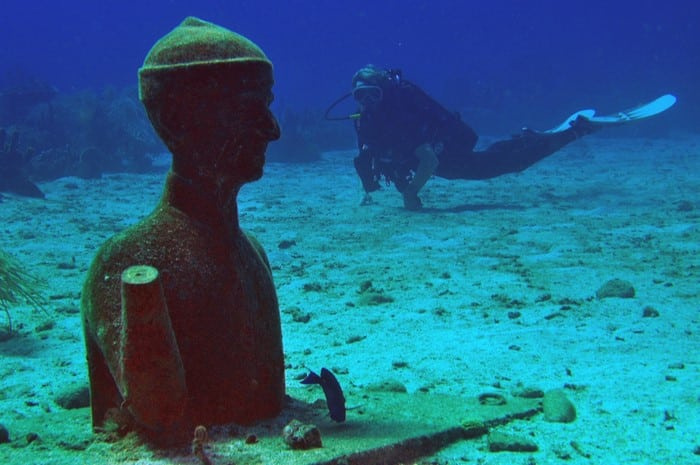
travel2guadeloupe.com 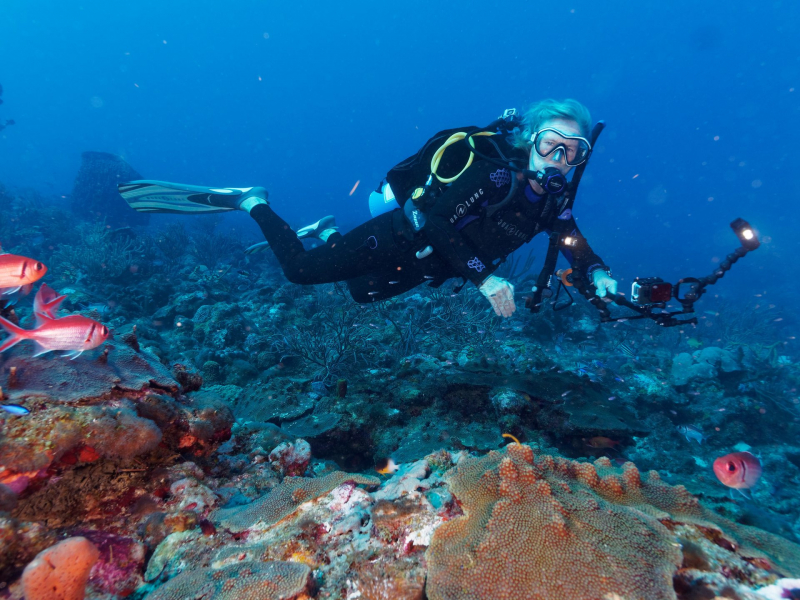
padi.com -
When you arrive at this location, the crystal clear water and brilliant blue everywhere will catch your attention. A wonderful shallow sandy learning space awaits you. The fact that three different courses begin from the same point is what makes this location so special. Since 2018, a little hawksbill turtle and a yellow seahorse have made their home here. Beautiful thazards and barracudas regularly pass by here, so keep an eye out in the blue. In English, La Piscine is known as "The Pool," and it clearly resembles pool-like conditions in open water. It's an excellent dive site for new divers or those looking to brush up on their skills. Due to the presence of a huge white sandy stretch, scuba training is regularly undertaken in this region.
- Area with a shallow sandy bottom that is perfect for dive training.
- The proximity to the coral reef allows you to learn to dive in a stunning setting.
- Excellent location for a first dive after a lengthy layoff.
What you'll see: A beautiful coral reef packed with life may be seen at this shallow dive site. See how many different butterflyfish, damsels, and other reef fish you can find swimming about. There are also many eels lurking in crevices in the reef, as well as well-hidden crabs densely packed into coral.
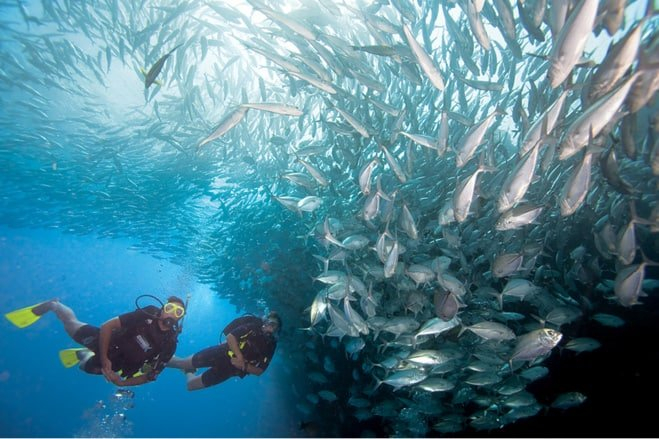
scubadivegeek.com -
Point Carrangue is one of the best dive sites in Guadeloupe (France). This beautiful dive location is located in a quiet harbor and boasts visibility of up to 98 feet. Open water divers are invited to explore the stunning coral reef bommies and plateaus covered with fish life at this dive site. Carangue Point is situated between two diving destinations. It is accessible from the Swimming Pool or the Coral Garden locations and ranges in length from 10 to 30 meters. A moderate to strong current exists. When the wind is high, it is best to lie down on the ground to view the big-eyed jackfish broom. This location is a true fish festival. Thazards, barracudas, and hawksbill turtles can be seen coming up to take a breath among the shoals of fish when there is a current.
- The dive spot is suitable for divers of all levels.
- Depths can reach 40m, therefore keep to your certification level.
- A healthy coral reef is a home to a diverse range of marine species.
What you'll see: Turtles, tunas, groupers, lizard fish, sea urchins, trumpet fish, and anemonefish call the coral reef home! Stingrays are very common in this area and make an excellent photographic subject. If you want to view some moray eels, look in crevasses and under ledges for these timid critters. See how many trevallies you can identify, as this diving location is named for them!
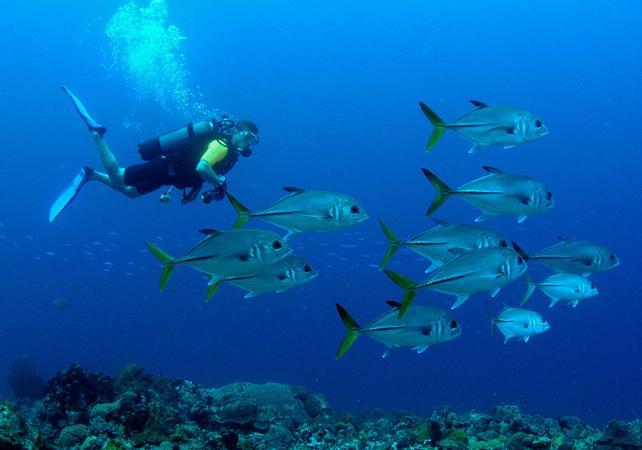
ceetiz.hk 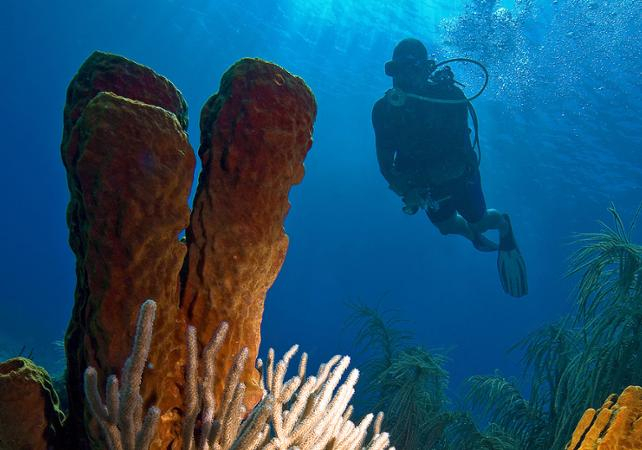
ceetiz.hk -
Divers may dive among numerous huge boulders at a rather shallow depth off the coast of Malendure. These rocks are home to a plethora of marine life as well as intriguing coral growths. Typically, there isn't much of a current, making the dive location suitable for divers of all skill levels. Unfortunately, visibility is often poor. Malendure's crown jewel. This is a fantastic dive spot that is well-liked by local divers. This dive may be done while floating towards Jardin Japanese or Anse négresse. Turtles, barracuda, moray eels, lobsters, and other Caribbean marine species in one dive: the best of Malendure.
- Diverse underwater topography
- This region is teeming with aquatic life.
- Excellent location for observing macrofauna.
What you'll see: The rocks are a famous swimming and hunting site for barracudas, snapper, cassava, and lionfish. It's almost worth not moving much and just watching these gorgeous fish dart about. Sea urchins and other tiny invertebrates can also be found on the seafloor.
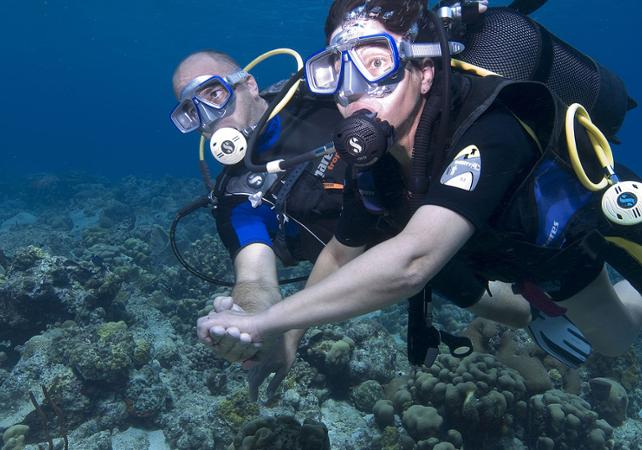
ceetizz.hk -
The National Park's northernmost point is on the axis of the Route de la Traversée. The location is located immediately before the entrance to the village of Pointe Noire, near the northernmost tip of the National Park region. It is worth exploring because it is infrequently frequented and has a shallow depth (maximum 20m). There are barracudas, damsels, angelfish, gorettes, and much other fish that can be seen. There are turtles as well. Another interesting concentration of rocks at a comfortable 65 feet is an excellent dive location for intermediate divers. There are numerous aquatic species all along with the rocky formations. This is an excellent diving spot for a lengthy drive to identify as many marine animals as possible.
- Suitable for intermediate divers
- Every rock is teeming with aquatic life.
- Excellent location for photography practice.
What you'll see: The normal reef species, such as parrotfish, butterflyfish, and surgeonfish, may all be seen swimming about the rocks. These are brilliantly colored and would make excellent photographic subjects. See what well-camouflaged creatures you can discover to put your identification abilities to the test. There are plenty of stonefish, lionfish, trumpet fish, sea horses, and frogfish lurking in plain sight at this dive location
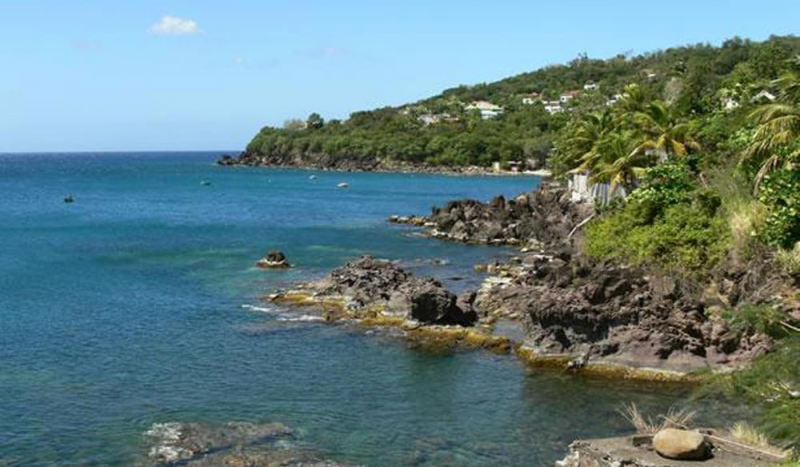
divein.com 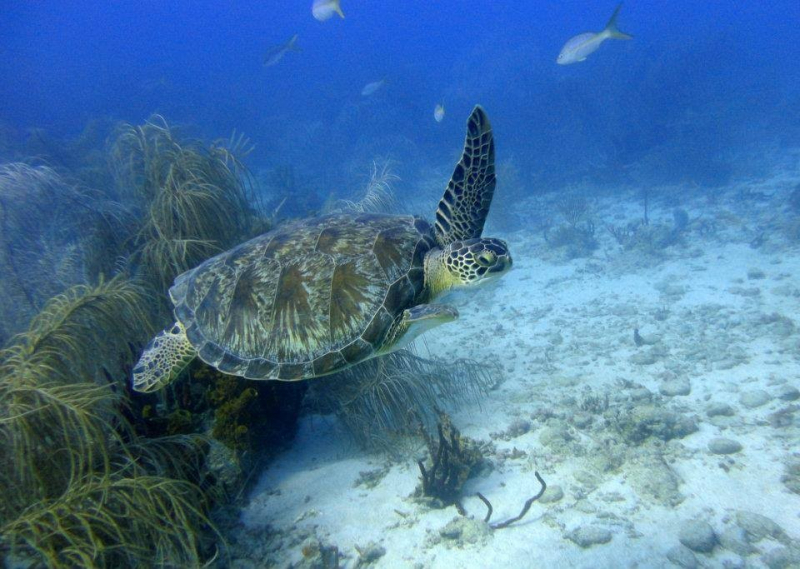
tribloo.com


















